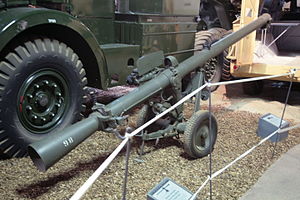120 mm BAT recoilless rifle
| L6 Wombat | |
|---|---|
 A Wombat at Imperial War Museum Duxford | |
| Type | Recoilless rifle |
| Place of origin | United Kingdom |
| Service history | |
| Used by | Great Britain Australia |
| Wars | Vietnam War |
| Production history | |
| Designed | 1950s |
| Specifications | |
| Mass | 308 kg (679 lb) |
| Length | 3.86 m (12 ft 8 in) |
| Barrel length | 33.33 calibres |
| Height | 1.09 m (3 ft 7 in) |
| Crew | 3 (DC) Detachment Commander, (No.1) Spotter + main armament loader + maintained the spotting Rifle, (No.2) Driver, main armament unloader and rear security + back blast observer |
| Shell | 12.8 kg (28 lb 4 oz) HESH |
| Calibre | 120 mm (4.7 in) |
| Elevation | -8 to +17° |
| Traverse | 360° |
| Rate of fire | 4 rounds per minute |
| Muzzle velocity | 463 m/s (1,520 ft/s)[1] |
| Effective firing range | 1,000 m (1,100 yd) |
| Maximum firing range | 1,610 m (1,760 yd) |
| Sights | Optical with spotting rifle |
The L2 BAT (Battalion, Anti-Tank) was a 120 mm calibre recoilless anti-tank rifle used by the British Army. It was also produced in the MOBAT version without a gun shield, and the ConBAT version with a new spotting rifle attachment. The L6 Wombat version was greatly lightened through the use of magnesium alloys hence the name (Weapon Of Magnesium Battalion Anti-Tank). The Wombat was used by mobile units such as paratroopers and marines.[2] the Wombat was also issued to some TA battalions such as 5th Battalion, The Royal Anglian Regiment
BAT was developed from the wartime Ordnance, RCL, 3.45 in,[3] replacing it and the Ordnance QF 17-pounder to become the standard anti-tank weapon of the Army in the post-World War II era. The BAT and MOBAT were used until anti-tank guided missiles, such as Vigilant and MILAN, took their place. WOMBAT remained in anti-tank platoons in Berlin to supplement MILAN until the late 1980s, due to the expected engagement ranges should the Warsaw Pact have ever attacked. The wire guidance of MILAN would also have been problematic in the built up areas of Berlin. It was envisioned that Wombat would be used in 'shoot-and-scoot' attacks mounted on the back of stripped down Land Rover vehicles.
The Wombat was a development version which was adopted and replaced the earlier BAT and MOBAT weapons.
The usual round for Wombat was a
During the
Wombats were among the anti-tank weapons taken by the Parachute Regiment to the Falklands War in 1982, but they were not off-loaded from the transport ships.[6]
Operators
Non British users of the MOBAT variant were Jordan, Kenya, Malaysia and New Zealand.[7] Australia used the WOMBAT variant.[7]
Variants
- L2 BAT, Battalion Anti Tank
- The original towed gun complete with a heavy armoured shield and wheeled mount. Accepted for service in 1953.
- L4 MoBAT (Mobile BAT)[8]
- A BAT with the shield removed to lighten it (even though it still weighed some 770 kg (0.76 long tons) and a spotting weapon (a Bren light machine gun) added. It could be towed by an Austin Champ or, later, a Land Rover.
- L6 WOMBAT[9]
- A new build weapon with a lightweight carriage, which meant that it was usable by all air Mobile (Infantry Battalions) plus mobile troops, such as the Territorial Army.
- L7 CONBAT ("Converted BAT")
- A conversion of the L4 MoBAT or L2 BAT utilizing a L40A1 12.7 mm spotting rifle. (The American designation was the .50-cal M8C spotting rifle. It used a shorter cartridge than the .50-cal machine gun.) The tracer rounds matched trajectory with the CONBAT to 350.[10]
-
L6 Wombat being prepared for firing during winter training
-
Royal Marines Wombat outfitted Snow Trac on patrol in Norway
References
- Notes
- ^ "Britains-smallwars.com". Archived from the original on 2007-12-23. Retrieved 2010-02-07.
- ^ Weaponsystems.net
- ^ ASIN B009B70ZRG.
- ^ User Handbook for the Gun, Equipment, 120mm BAT, L6 (WOMBAT). Director of Infantry, Ministry of Defence. 1964. WO Code 14202.
- ^ Norris, p. 108.
- ISBN 978-0813313313.
- ^ ISBN 9781739354725.
- ^ MOBAT
- ^ In Men against Tanks, author John Weeks states the name "Wombat" was a reference to the animal and had nothing to do with magnesium.
- ^ Copeson, Chris (5 May 2023). MOBAT, WOMBAT, CONBAT | Anti-Tank Chats. The Tank Museum. Event occurs at 9:46-9:58. Retrieved 5 May 2023.
- Bibliography
- Norris, J., Anti-tank Weapons (Modern Military Equipment), Brassey's (UK) Ltd, 1996. ISBN 1-85753-177-9
External links
| External images | |
|---|---|
| BAT guns | |


